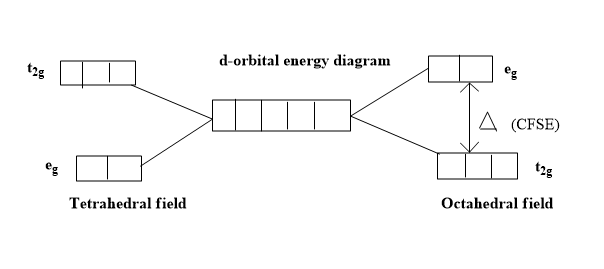
For an octahedral complex, which of the following d-electron configurations will give maximum CFSE?

(A) High spin
(B) Low spin
(C) Low spin
(D) High spin

Answer
468k+ views
Hint: The value of CFSE is more in the given options for the option (C). However it can be understood from the calculation.
Complete step by step answer:
Crystal field splitting energy, CFSE for octahedral complexes is calculated from the following formula,
Let us calculate the CFSE for all the given electronic configurations. Let us consider,
- Option (A), in the high spin
=
=
- Option (B), in low spin
=
- Option (C), for low spin
- Option (D), in the high spin
=
=
=
From the above obtained values of Crystal field stabilization energies, the value for low spin
The correct answer is option “C” .
Additional Information : The stabilization energy gained by the complex by filling electrons in lower energy
Note: The electrons are filled in the orbitals for calculating CFSE by considering whether the given complex is a low spin complex or a high spin complex. In a low spin complex pairing of electrons takes place whereas in a high spin complex, all the degenerate orbitals are filled by one electron each and then pairing occurs.
Complete step by step answer:
Crystal field splitting energy, CFSE for octahedral complexes is calculated from the following formula,
Let us calculate the CFSE for all the given electronic configurations. Let us consider,
- Option (A), in the high spin
=
=
- Option (B), in low spin
=
- Option (C), for low spin
- Option (D), in the high spin
=
=
=
From the above obtained values of Crystal field stabilization energies, the value for low spin
The correct answer is option “C” .
Additional Information : The stabilization energy gained by the complex by filling electrons in lower energy
Note: The electrons are filled in the orbitals for calculating CFSE by considering whether the given complex is a low spin complex or a high spin complex. In a low spin complex pairing of electrons takes place whereas in a high spin complex, all the degenerate orbitals are filled by one electron each and then pairing occurs.
Recently Updated Pages
Master Class 9 General Knowledge: Engaging Questions & Answers for Success

Master Class 9 English: Engaging Questions & Answers for Success

Master Class 9 Science: Engaging Questions & Answers for Success

Master Class 9 Social Science: Engaging Questions & Answers for Success

Master Class 9 Maths: Engaging Questions & Answers for Success

Class 9 Question and Answer - Your Ultimate Solutions Guide

Trending doubts
State and prove Bernoullis theorem class 11 physics CBSE

Who built the Grand Trunk Road AChandragupta Maurya class 11 social science CBSE

1 ton equals to A 100 kg B 1000 kg C 10 kg D 10000 class 11 physics CBSE

State the laws of reflection of light

One Metric ton is equal to kg A 10000 B 1000 C 100 class 11 physics CBSE

Difference Between Prokaryotic Cells and Eukaryotic Cells




